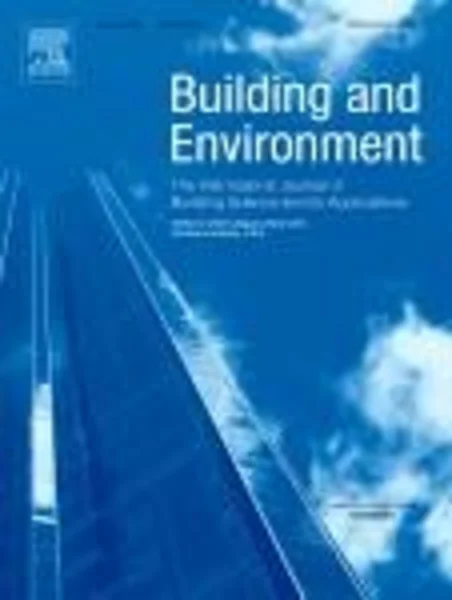-
transient buoyancy-driven ventilation: part 2. modelling heat transfer
جزئیات بیشتر مقاله- تاریخ ارائه: 1390/01/01
- تاریخ انتشار در تی پی بین: 1390/01/01
- تعداد بازدید: 638
- تعداد پرسش و پاسخ ها: 0
- شماره تماس دبیرخانه رویداد: -
a new mathematical model for buoyancy-driven ventilation [sandbach sd, lane-serff gf. transient buoyancy-driven ventilation: part 1. modelling advection. building and environment, 2011] is modified to include heat transfer at the boundaries. heat transfers at the ceiling and floor are included, using newton’s law of cooling to model convective heat transfer between the air and the solid boundaries, fourier’s law to model conductive heat transfer through the floor and ceiling, and a linear version of the stefan–boltzmann law to model radiative heat transfer from the ceiling to the floor. the effectiveness of the model was assessed using experimental results obtained in a full-scale test room. in these experiments, the vertical temperature stratification was measured using an array of t-type thermocouples. speed measurements were obtained to estimate the ventilation flow rate (for displacement ventilation) and the velocity profile across the doorway (for doorway ventilation). buoyancy was introduced using a twin-hob (∼2.35 kw) heat source, and in most cases a diffuse two-layer temperature stratification developed. the results from these experiments are compared with the model and existing adiabatic models. our results indicate that the effect of heat transfer at the boundaries on the final stratification is significant and should not be ignored. furthermore, direct comparisons between the measured and modelled results are in general very good.
مقالات جدیدترین رویدادها
-
استفاده از تحلیل اهمیت-عملکرد در ارائه الگوی مدیریت خلاقیت سازمانی و ارائه راهکار جهت بهبود
-
بررسی تاثیر ارزش وجوه نقد مازاد بر ساختار سرمایه شرکت های پذیرفته شده در بورس اوراق بهادار تهران
-
بررسی تأثیر سطح افشای ریسک بر قرارداد بدهی شرکت های پذیرفته شده در بورس اوراق بهادار تهران
-
بررسی تأثیر رتبه بندی اعتباری مبتنی بر مدل امتیاز بازار نوظهور بر نقد شوندگی سهام با تأکید بر خصوصی سازی شرکت ها
-
تأثیر آمیخته بازاریابی پوشاک ایرانی بر تصویر ذهنی مشتری پوشاک ایرانی (هاکوپیان)
-
مقایسه تاثیر انواع الیاف بر مشخصات بتن
-
تحلیل دینامیکی پل های مورب با سخت کننده های طولی تحت بارهای متحرک به روش نوار محدود به منظور تعیین ضرایب تقویت دینامیکی
-
گزارش 1 مورد شوانوما با تظاهر توده زبانی
-
blind bolted moment connection to unfilled hollow section columns using extended t-stub with back face support
-
effects of y2o3 nanoparticles on growth behaviors of cu6sn5 grains in soldering reaction
مقالات جدیدترین ژورنال ها
-
مدیریت و بررسی افسردگی دانش آموزان دختر مقطع متوسطه دوم در دروان کرونا در شهرستان دزفول
-
مدیریت و بررسی خرد سیاسی در اندیشه ی فردوسی در ادب ایران
-
واکاوی و مدیریت توصیفی قلمدان(جاکلیدی)ضریح در موزه آستان قدس رضوی
-
بررسی تاثیر خلاقیت، دانش و انگیزه کارکنان بر پیشنهادات نوآورانه کارکنان ( مورد مطالعه: هتل های 3 و 4 ستاره استان کرمان)
-
بررسی تاثیر کیفیت سیستم های اطلاعاتی بر تصمیم گیری موفق در شرکتهای تولیدی استان اصفهان (مورد مطالعه: مدیران شرکتهای تولیدی استان اصفهان)
-
محدودیت فروش کوتاه مدت و خطر سقوط قیمت سهام با تاکید بر کارایی سرمایه گذاری
-
طراحی الگوی فرایند دانش آفرینی در دانشگاه بر اساس رویکرد آمیخته
-
بررسی اثر اقتصاد سیاسی پشت سر استقلال بانک مرکزی
-
خسارت ناشی از تأخیر در تحویل کالا و خسارات معنوی و اقتصادی در خصوص حمل و نقل دریایی
-
ارتباط بین استقرار مدیریت دانش و توانمندسازی با عملکرد شغلی کارکنان




سوال خود را در مورد این مقاله مطرح نمایید :